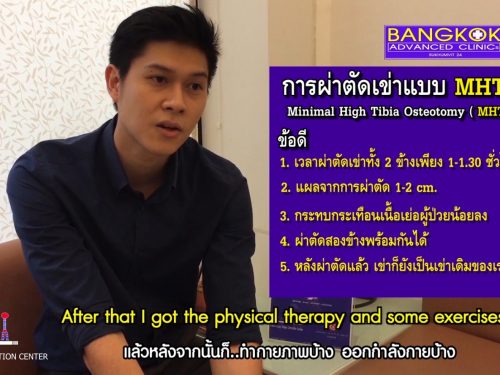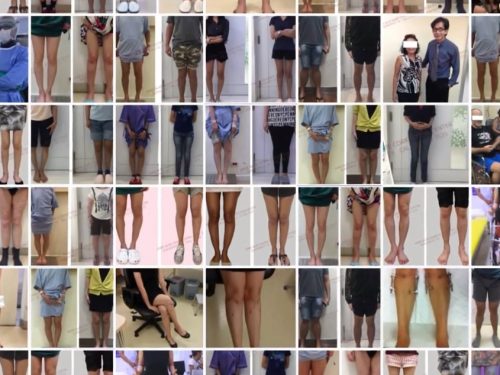
“The operation to straighten both knees at the same time with the new MHTO Method”
Frequent questions from patients who have bowlegs or knock-knees on both sides from a young age are:
- Can the operation be done on both sides on the same day?
- Is there a difference between knock-knees and bowlegs?
- Will there be a difference if the operation is done on one side at a time?
- And the most important question is: Has this kind of operation (same-day-both-knees) been practiced in Thailand?
The operation on both knees at the same time


The operation on both legs at the same time is not new but in the past, it is scarcely done. The reasons:
- Technology and tools before were not as good as what we have now (there is no real time x-ray that can measure the angle of distortion).
- There is only one method of putting in the titanium pedicular screw and fixing it to the bone after cutting the flesh open; the angle of the distortion cannot be adjusted after the wound is closed.
- There was no Modified High Tibia with Charnley Clamp technique that inserts the instrumentation from outside in the past (the previous correction of the distortion angle as result of the operation was not satisfactory)
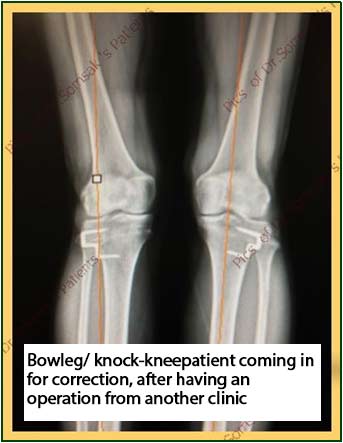
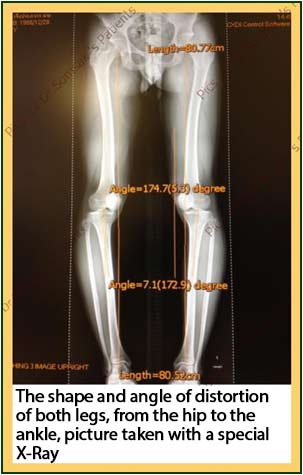
The main reason why the operation is not widely done in Thailand is because there are more patients having one-sided bowleg than both sides. I often warn patients who come for treatment of knee pain or the one’s having a deteriorated knee or knock-knee to have the corrective operation procedure as soon as possible before the problem starts in the other leg. The problem in one leg will make the patient shift the body weight onto the other leg; the unbalance weight will eventually cause the other leg to become bowed too.

Modified High Tibial Osteotomy with Charnley Clamp technique can be used to correct bowlegs on both sides at once.
The comparison of two methods (One side first Or Same-day-both-knee surgery) are as follows:
1. Time of recovery: Surgery on both sides simultaneously recovers faster
After the operation on both sides, the patient can still sit on a chair while bending the knees and placing the feet on the ground since this type of surgery does not cut through the bone below the knee, but on the knee joints where movement is not affected. The knee joint can still move without the impact force so the patient can bend the knees as usual. The Modified High Tibial Osteotomy with Charnley Clamptechnique (instrumentation brackets fixator on the outside) is strong enough, that even when the patient moves to sit on the chair, the wound will not be impacted.
After the operation on one side, the patient needs to rest for 2-3 months before the operation on the other side can be done. The patient is not allowed to put body weight on the operated leg and is advised not to place the foot on the ground. To walk, the patient needs to use crutches or walker since moving can cause a shift on the operated bone from the corrected angle or the bone fixation will be slower.
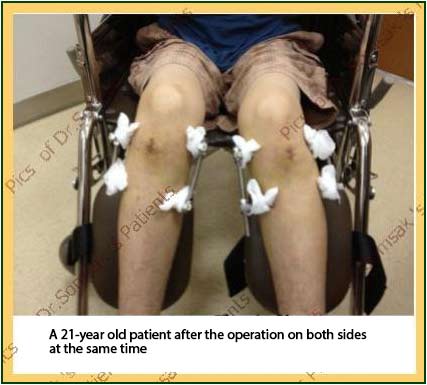
After 4-6 weeks, when the bone is tightly welded together, the patient is then allowed to put body weight on that foot. As soon as the instrumentation had been taken off (no need for another operation unless the fixator is inside), the tight muscle needs to recover first, thus needing therapeutic exercises until the patient can walk without crutches, before an operation on the other side is scheduled. Recovery time usually takes about 2-3 months.
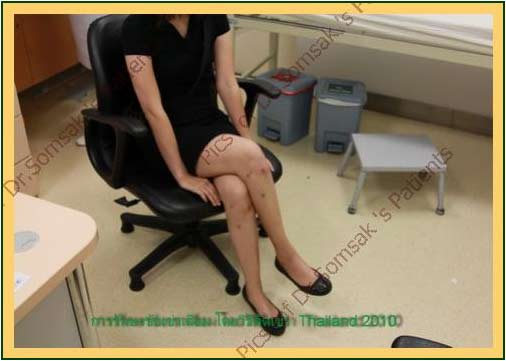
The operation on both sides, simultaneously, will speed up the recovery process by twice as much because both legs can recuperate at the same time.
2. Caring for your incision after the operation
After the operation on both legs, the patient, temporarily, cannot put body weight on the feet and will need to use a wheel chair for 4-6 weeks. This is because the bone needs time to weld together and any movement will cause a shift of the bone. This is the drawback, compared to the operation on one side at a time when the patient, using crutches, can still move around with one leg.
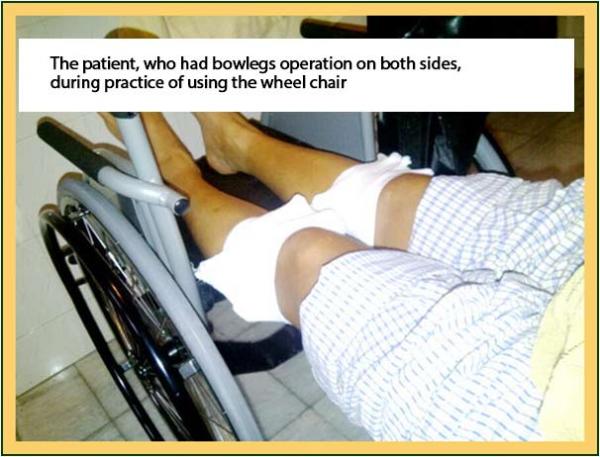
Before the operation on both legs, the patient will be taught to practice using the wheel chair to continue daily life’s routine, i.e. going to the rest room, getting in/out of bed and getting on and off the wheel chair. To sit, the patient can still, of course, bend the knee and even place the feet on the plate of the wheel chair, keeping in mind that recovery time of 4-6 weeks is a must until full recovery.
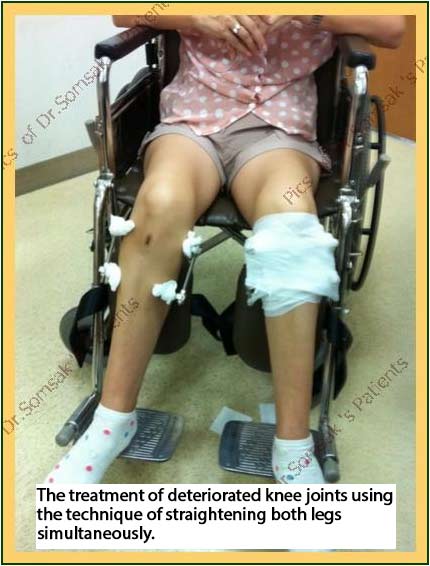
As soon as the x-ray confirms complete welding of the bone, after four to six weeks, the patient can try to start walking as usual once the outer fixator is removed. For patients with weak thigh muscle they may have to use supporting stretcher in the first week after the instrumentation is removed; the muscle around the ankle will need to adjust first since leg movements were restrained for quite some time. After that, walking without the stretcher will become much easier.
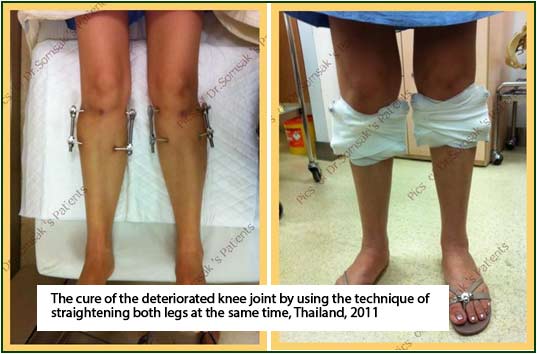
Some patients, however, recover differently after the operation on both sides so the removal of the fixator may have to be at a later time since the welding of the bones might not have the same recovery rate on both sides. Hence, the time difference is not more than one week.
3. Cost
The cost of the operation for same-day-both-knee surgery is lower since the patient will only be admitted to the hospital (3-4 days) once. The time spent in the surgery room and the use of operation tools is minimal so the expense, of course, is lower; this is because the charging rate of time spent in private hospitals, after the first hour of the operation, is cheaper. Only one set of operation tools is used in a single operation of both knees, unlike with one knee per time where two sets of hospital tools are used separately.
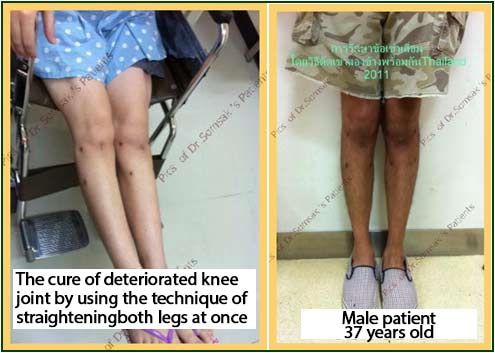
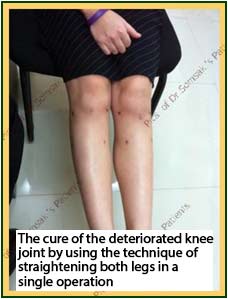
Same-day-both-knee operation, on the other hand, is only suitable for patients with strong thigh muscle since the post surgery recuperation time after removal of instrumentation is mostly self-dependent. Once the fixator is removed, there is also a need to undergo physical therapy and specialized exercise to strengthen the thigh muscle.

The bowlegs without any pain have no need for any treatment. However, treatment can be further discussed if patients find their leg appearance unsatisfactory or they are not that confident to wear short pants, skirts, or skin-tight jeans.
Example of the patients that have the operation to correct bowlegs, using MHTO techniques on the two legs at the same time.
Note : Actual photos (Credit to our patients)
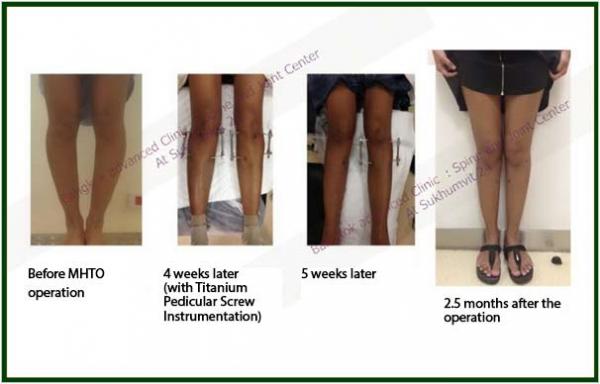




Actual photos (Credit to our patients)

RELATED ARTICLES
The Drawback of having bowlegs Part 1
When do you need surgery for bowlegs? Part 2
Varus knee (bow-legged) correction in young adults Part 3
Types of Bowlegs and Operation Methods to Cure Part 4
The operation to correct bowlegs, knock-knees Part 5

